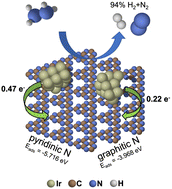Enhanced stability of sub-nanometric iridium decorated graphitic carbon nitride for H2 production upon hydrous hydrazine decomposition†
Abstract
Stabilizing metal nanoparticles is vital for large scale implementations of supported metal catalysts, particularly for a sustainable transition to clean energy, e.g., H2 production. In this work, iridium sub-nanometric particles were deposited on commercial graphite and on graphitic carbon nitride by a wet impregnation method to investigate the metal–support interaction during the hydrous hydrazine decomposition reaction. To establish a structure–activity relationship, samples were characterized by transmission electron microscopy and X-ray photoelectron spectroscopy. The catalytic performance of the synthesized materials was evaluated under mild reaction conditions, i.e. 323 K and ambient pressure. The results showed that graphitic carbon nitride (GCN) enhances the stability of Ir nanoparticles compared to graphite, while maintaining remarkable activity and selectivity. Simulation techniques including Genetic Algorithm geometry screening and electronic structure analyses were employed to provide a valuable atomic level understanding of the metal–support interactions. N anchoring sites of GCN were found to minimise the thermodynamic driving force of coalescence, thus improving the catalyst stability, as well as to lead charge redistributions in the cluster improving the resistance to poisoning by decomposition intermediates.

- This article is part of the themed collection: Stability and properties of new-generation metal and metal-oxide clusters down to subnanometer scale


 Please wait while we load your content...
Please wait while we load your content...